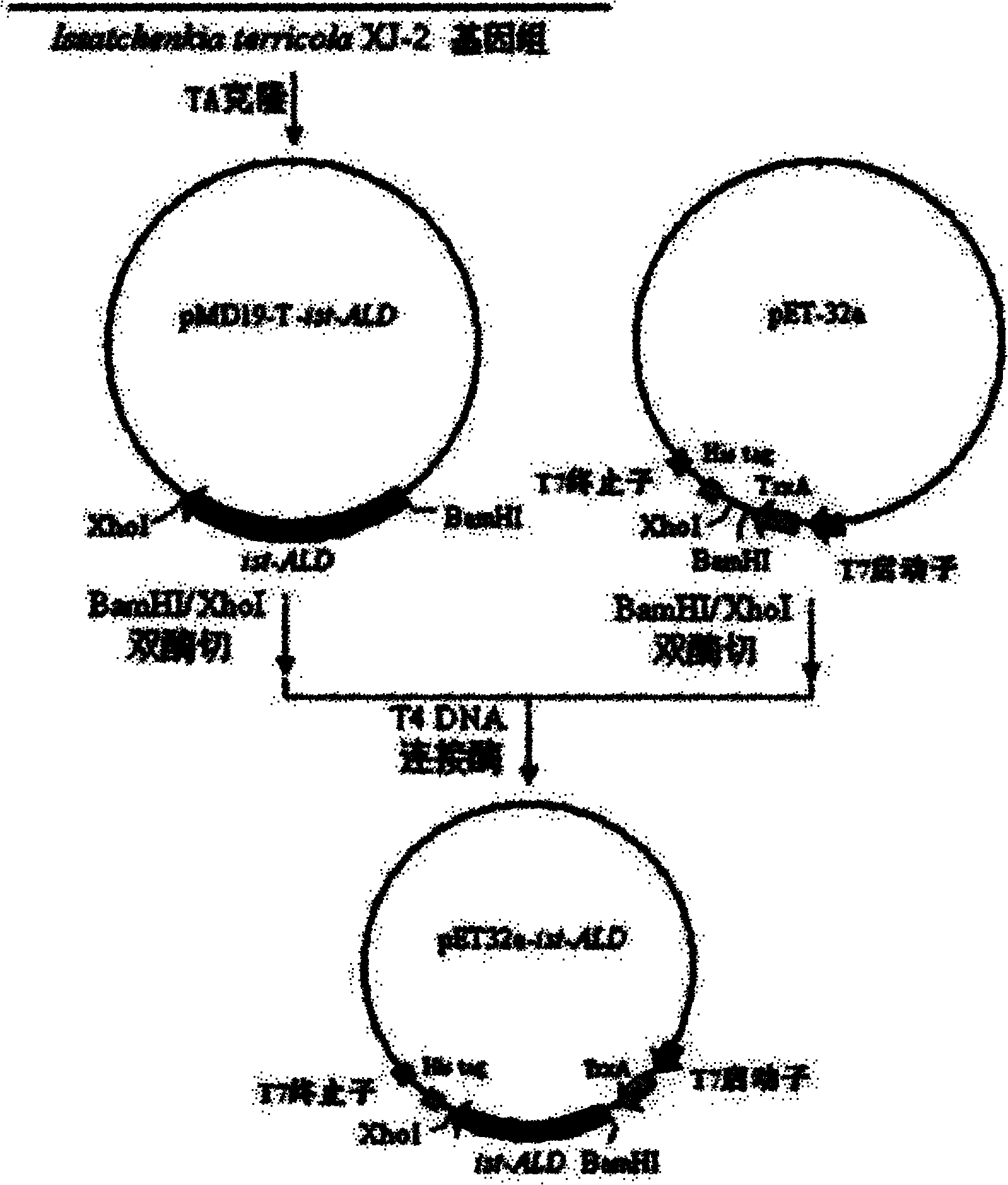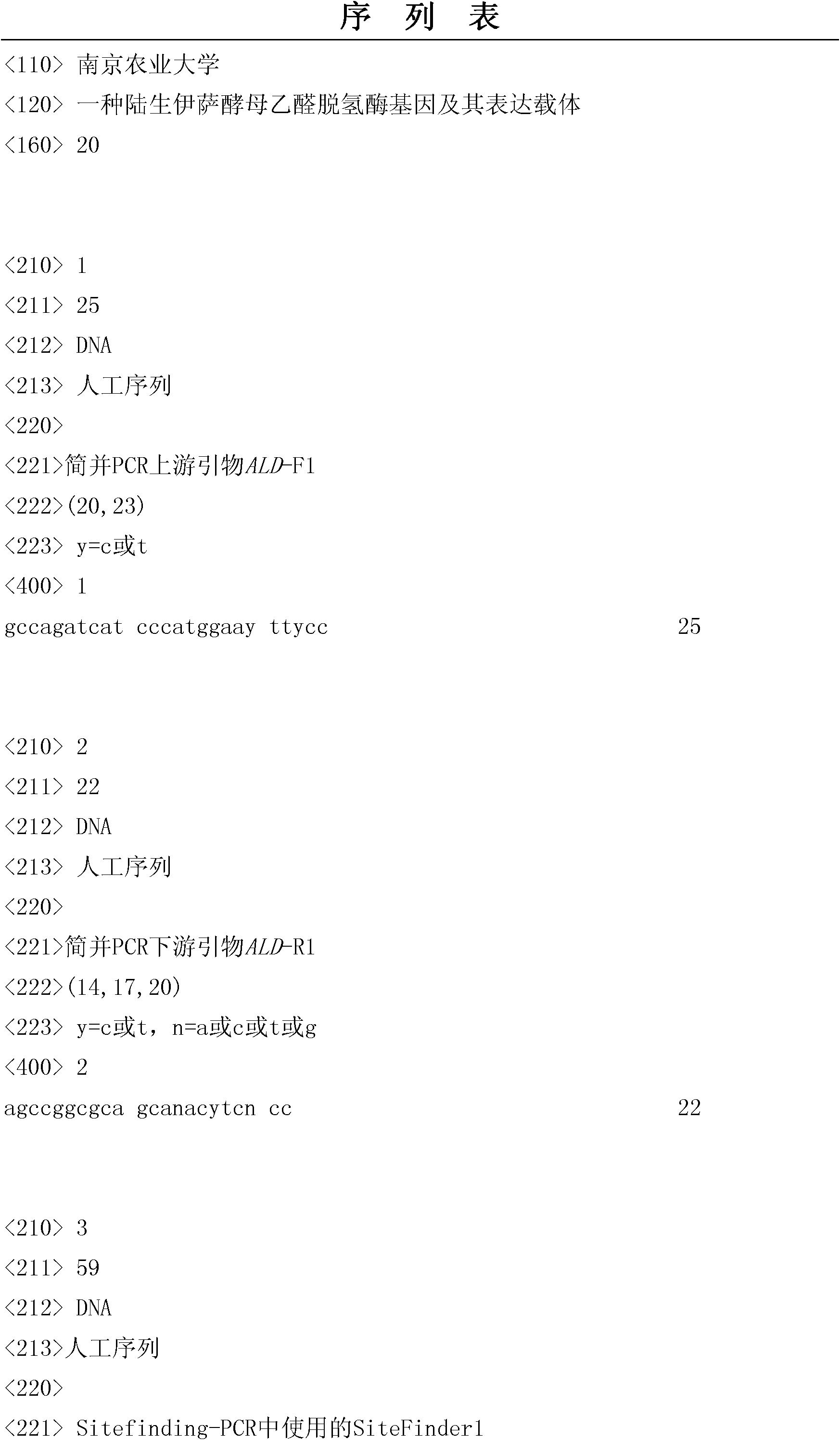Issatchenkia terricola acetaldehyde dehydrogenase gene and expression vector thereof
A technology of acetaldehyde dehydrogenase and Yisak yeast, which is applied in the direction of genetic engineering, plant gene improvement, and the introduction of foreign genetic material using vectors, etc., to overcome the low yield of acetaldehyde dehydrogenase production
- Summary
- Abstract
- Description
- Claims
- Application Information
AI Technical Summary
Problems solved by technology
Method used
Image
Examples
Embodiment 1
[0028] Example 1: Cloning of aldehyde dehydrogenase gene from Issatchenkia terricola XJ-2
[0029] Issatchenkia terricola XJ-2 was inserted into 100 mL of YPD medium and cultured at 30° C. and 200 rpm for 17 hours. The cells were collected by centrifugation, and the genomic DNA of Issatchenkia terricola XJ-2 was extracted by using the method for small preparation of yeast DNA in the "Molecular Cloning Experiment Guide".
[0030] Search for several yeast acetaldehyde dehydrogenase sequences from NCBI website, conduct bioinformatics analysis, and use CODEHOP (Consensus-degenerate hybrid oligonucleotide primers) program to select two highly conserved amino acid sequences VCGQIIPWN and GEVCCAGS, and design The degenerate primers ALD-F1 (SEQ ID NO.1) and ALD-R1 (SEQ ID NO.2) were used to perform degenerate PCR to amplify the sequence between the two conserved regions.
[0031] In a 50 μl system, the final concentrations of primers ALD-F1 (SEQ ID NO.1) and ALD-R1 (SEQ ID NO.2) are ...
Embodiment 2
[0035] Embodiment 2: the construction of terrestrial Issatch yeast (Issatchenkia terricola XJ-2) acetaldehyde dehydrogenase gene prokaryotic expression vector ( figure 1 )
[0036] According to the obtained aldehyde dehydrogenase gene sequence, design two primers, upstream primer ALD-F2 (SEQ ID NO.19) plus BamHI recognition sequence, downstream primer ALD-R2 (SEQ ID NO.20) plus XhoI recognition sequence (The underlined part is the restriction enzyme recognition sequence).
[0037] Add the components according to the following PCR system to amplify the acetaldehyde dehydrogenase gene: 10×Pfu PCR buffer 10μL, 10μM ALD-F2 4μL, 10μM ALD-R2 4μL, 2.5mM dNTPs 8μL, genomic DNA 10ng, Pfu DNA polymerase 5U, ddH 2 O to make up to 100 μL. The PCR program was 94°C for 5 min, 30× (94°C for 30 s, 60°C for 50 s, 72°C for 4 min), and 72°C for 10 min.
[0038] Purify the PCR product with Shanghai Sangon PCR Product Purification Kit, add BamHI and XhoI double digestion, inactivation, ethanol ...
Embodiment 3
[0039] Example 3: Expression of terrestrial Issatchenkia terricola XJ-2 acetaldehyde dehydrogenase gene in Escherichia coli
[0040] Transform the E. coli expression host strain BL21(DE3)pLysS containing the ist-ALD expression plasmid pET-32a-ist-ALD, and pick small colonies after culturing at 37°C for 10-11 hours on an LB plate containing 100 μg / mL ampicillin , insert 50ml LB liquid culture medium that adds 100μg / mL ampicillin and 0.2% (w / v) glucose, cultivate overnight at 70-90rpm 30°C, take the seed solution according to the volume ratio of 1:40 and add to the medium containing 100μg / mL ampicillin and 100mL LB liquid medium with 0.2% (w / v) glucose, shake at 180rpm at 37°C for 2-3 hours to OD 600 At about 0.6, add IPTG (final concentration 100 μg / ml) to induce expression at 16°C for 16 hours, and then collect the bacteria by centrifugation. Break up the bacteria, centrifuge to collect the supernatant, and use it as the crude enzyme solution of acetaldehyde dehydrogenase. T...
PUM
 Login to View More
Login to View More Abstract
Description
Claims
Application Information
 Login to View More
Login to View More - R&D
- Intellectual Property
- Life Sciences
- Materials
- Tech Scout
- Unparalleled Data Quality
- Higher Quality Content
- 60% Fewer Hallucinations
Browse by: Latest US Patents, China's latest patents, Technical Efficacy Thesaurus, Application Domain, Technology Topic, Popular Technical Reports.
© 2025 PatSnap. All rights reserved.Legal|Privacy policy|Modern Slavery Act Transparency Statement|Sitemap|About US| Contact US: help@patsnap.com



